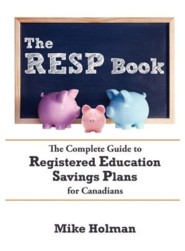When the RESP beneficiary (student) is ready to go to school, the subscriber (owner of RESP account) needs to start withdrawing money from the RESP account. To withdraw money you have to provide some proof to your resp provider that the resp beneficiary (child) is going to an approved post-secondary school. You don’t have to show receipts for specific purchases.
Two types of money in the RESP account
In your RESP account, there are two different types of money: contributions and accumulated income.
- The contribution amount is the sum of all the contributions that you made to the account over the years.
- The accumulated income is made up of grants, capital gains, interest, dividends earned in the account.Any money that is not a contribution is considered to be accumulated income.
This distinction is important because the taxation of withdrawals from the contribution portion of the account is different than withdrawals from the accumulated income portion.
- Contribution withdrawals are not taxed.
- EAP (educational assistance payments) which are withdrawals of accumulated income, are taxed as income at the hands of the student.
The good news is that students have the personal exemption, as well as tuition tax credits which helps lower their tax bill. Obviously income earned during summer jobs or on co-op work terms will affect their taxes as well.Another bit of good news is that you can tell your financial institution if you are with drawing contributions or EAP (or both) so you can manage the taxes to some degree.
Please note there is no withholding tax on any kinds of RESP withdrawals, so if the student ends up in a taxable situation, they will have to pay the taxes at tax filing time.
A withdrawal limitation
First – one withdrawal rule to get out of the way – you are only allowed to withdraw $5,000 of accumulated income in the first 13 weeks. After 13 weeks, you can withdraw as much accumulated income (via EAP) as you wish. There are no limits to withdrawals from the contribution portion as long as the child is attending school.
Basic RESP withdrawal strategy
When planning the withdrawals, try to withdraw as much accumulated income money as you can tax free.For example when the student first starts school, they will have just completed a short summer (two months) so they probably won’t have much income for the year. That might be a good time to maximize payments from the accumulated income portion of the account (EAP).
On the other hand, if the student is in a co-op program and has two work terms in one year and only one school term, that might be a good year to take out contributions rather than accumulated income.
You don’t want to end up with accumulated income in the RESP account if the child is no longer going to school.
What if your child doesn’t go to school?
What happens if Junior decides that school is not for him? You have to collapse the plan and pay a pile of tax on it.
First of all you have lots of time to collapse the plan so don’t do it right away. It’s always possible that your child will give up on their pro hockey or musician career and will need the money for schooling later on. You can keep the account open for 35 years after the year in which the account was opened.
If you do collapse the plan, the contributions are tax free, anything else (accumulated income) is added to the subscriber’s gross income for taxation purposes.And on top of that, the accumulated income is charged a tax of 20%.
If you are retired or have any way to reduce your income in the year you collapse a resp plan, do it to save taxes.
What if the child does more than one session at school (ie multiple degrees)?
You are allowed to use the RESP for one degree and then keep some money in the account for future education. The only limit is the 35 year limit previously mentioned. Be warned that it’s not a bad idea to take out all the RESP money during the first degree so that there are minimal taxes and no penalties. If you save money in the RESP account for future degrees and the child doesn’t end up using the money, there will be increased taxes and penalties.
More RESP information
8 Things you need to know about withdrawing money from your RESP account. Lays out the details of how to actually withdraw the money.
How to withdraw excess money from your RESP account. Some strategies for withdrawing extra RESP money without penalty. This applies if the student started school and quit early or ended up with extra money.
How to avoid RESP withdrawal penalties if the child doesn’t go to school. If you child ends up not using the RESP at all – here are some ideas to avoid penalties and taxes.
More RESP information – Comprehensive list of RESP articles on this site.
